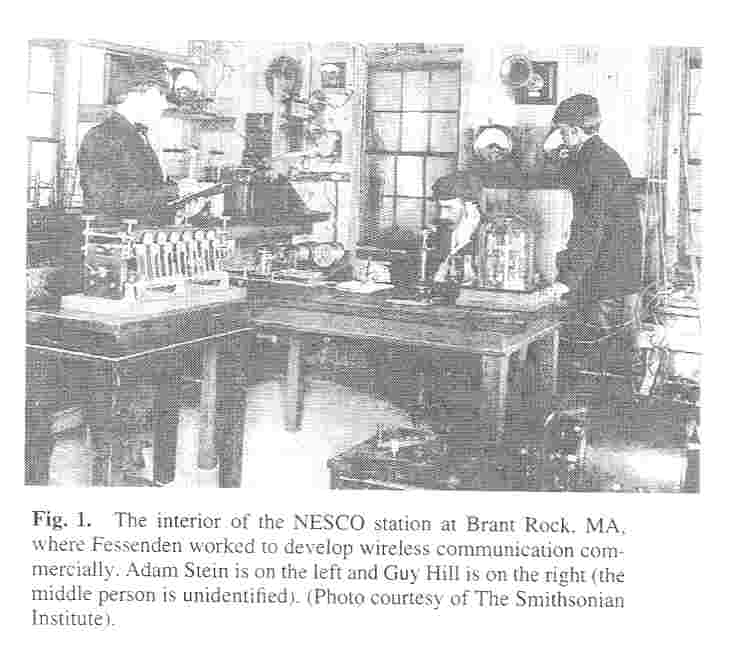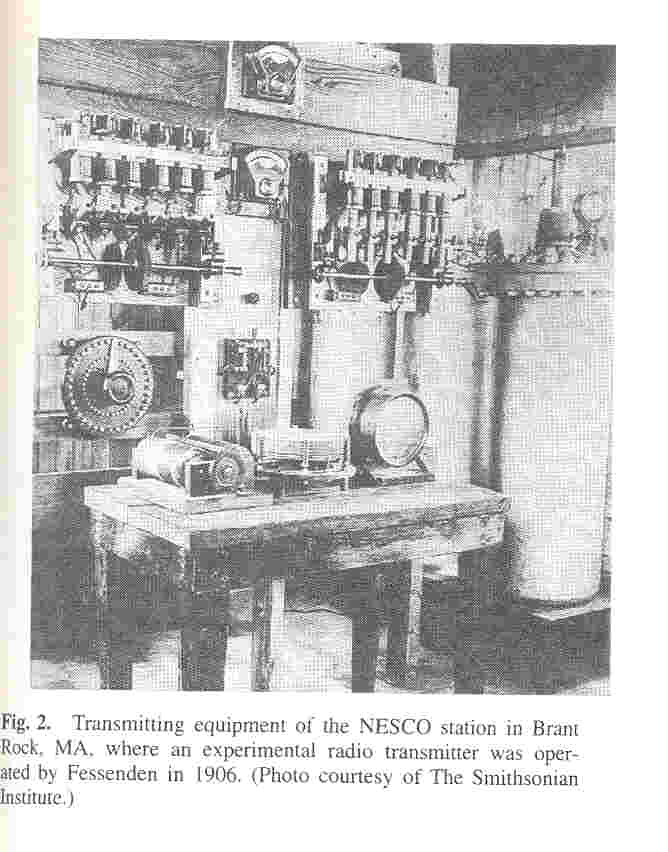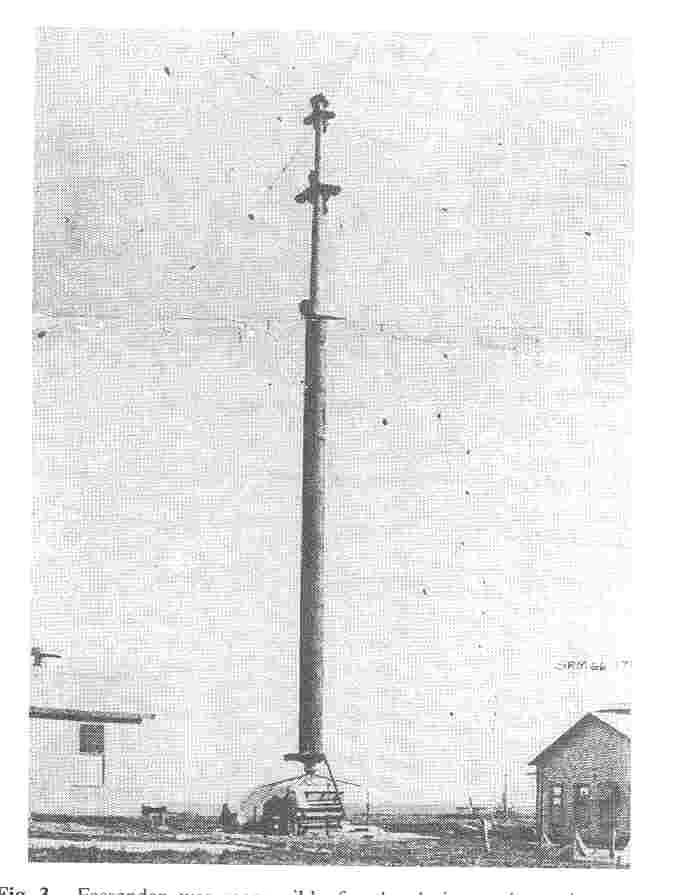November 2010 History
Scanning the Past: A History of Electrical Engineering from the Past
Submitted by Marc Bell, Editor
Copyright 1996 IEEE. Reprinted with permission from the IEEE publication, “Scanning the Past” which covers a reprint of an article appearing in the Proceedings of the IEEE Vol. 84, No. 12, December 1996.
Reginald A. Fessenden and the Origins of Radio
Ninety years ago this month, an experimental radio transmitter (Fig. 1) located in Brant Rock, MA, and operated by Reginald A. Fessenden, broadcast a brief program of voice and music on Christmas Eve and again on New Year’s Eve. The transmitting station employed a radio-frequency alternator constructed for Fessenden by the General Electric Company and was picked up by shipboard operators as far away as the West Indies. As a well-known pioneer in radio communications, Fessenden became a strong advocate of continuous-wave radio as an alternative to spark systems and he opposed excessive government regulation of the emerging industry. A prolific inventor, he introduced a number of important technical innovations and was awarded the Medal of Honor of the Institute of Radio Engineers in 1921.
The son of an Episcopal minister, Fessenden was born
in 1866 in East Bolton, Quebec, Canada. He graduated from Trinity College School and continued his education at Bishop’s College while teaching mathematics at Bishop’s College School. He then taught for two years at Whitney Institute in Bermuda before moving to New York City in 1886 where he worked as a tester for the Edison Machine Works on electric power distribution systems. In 1887, he joined the research staff at Edison’s new laboratory facility in West Orange, NJ, and worked there for about three years. He also worked for the United States Electric Company and for the Stanley Electric Company before accepting an invitation to teach electrical engineering at Purdue University in 1892. The following year, he joined the engineering faculty at the Western University of Pittsburgh where he taught and did research for the next seven years.
Fessenden and some of his more advanced students undertook research relating to wireless communication and he presented a paper on “the possibilities of wireless telegraphy” at a meeting of the American Institute of Electrical Engineers in November 1899. He also proposed an “electrostatic doublet” theory of atoms in solids and used it in an attempt to link data on atomic volume and spacing to properties of materials such as cohesion and elasticity. In 1900 he published a paper in the Physical Review concerning fundamental theories of matter, electricity, magnetism, and the ether.
 Fessenden gave up his academic position in 1900 to accept an offer from the United States Weather Bureau to develop a wireless network for communication with weather stations. It was during this period that he invented the liquid barreter as a wave detector which proved more sensitive and reliable than the coherer detector. The barreter employed a thin platinum wire immersed in a cup of nitric acid as a rectifier of high-frequency signals. Fessenden also conceived the heterodyne radio receiver which employed a local oscillator to mix with incoming signals.
Fessenden gave up his academic position in 1900 to accept an offer from the United States Weather Bureau to develop a wireless network for communication with weather stations. It was during this period that he invented the liquid barreter as a wave detector which proved more sensitive and reliable than the coherer detector. The barreter employed a thin platinum wire immersed in a cup of nitric acid as a rectifier of high-frequency signals. Fessenden also conceived the heterodyne radio receiver which employed a local oscillator to mix with incoming signals.
The Weather Bureau project proved unsuccessful but, in 1902, Fessenden persuaded two Pittsburgh financiers to invest in a new firm known as the National Electric Signaling Company (NESCO) to develop wireless communication commercially. The broadcasts from Brant Rock in December 1906 were part of an effort by NESCO to publicize and market the wireless system developed by Fessenden and his assistants. Fig. 2 shows part of the transmitting control apparatus while Fig. 3 is a photograph of the antenna and supporting structure used to transmit the broadcast. The Christmas Eve program as recounted by Fessenden consisted of:
. .. first a short speech by me saying what we were going to do, then some phonograph music Then came a violin solo by me . . . which I sang one verse of, in addition to playing the violin, though the singing, of course, was not very good. Then came the Bible text, Glory to God in the highest and on earth peace to men of good will, and we finally wound up by wishing them a Merry Christmas and then saying that we proposed to broadcast again on New Year’s Eve. Fessenden mentioned that he had been unable to persuade any of his colleagues to play music, sing, or talk and “consequently had to do it all myself.”
Following disputes over marketing strategy with his financial backers, Fessenden terminated his connection with NESCO in 1911 and it soon went into receivership. He did some consulting work for the Submarine Signal Company during World War I and invented a sonic depth finder. He became involved in protracted patent litigation with the Radio Corporation of America during the 1920’s which culminated in an out-of-court settlement which enabled him to retire to Bermuda. Late in life, he became interested in ancient accounts of the lost continent of Atlantis and authored a treatise entitled “The Deluged Civilization of the Caucasus Isthmus.” He died in 1932 at age 65.
James E. Brittain

Fig. 3. Fessenden was responsible for the design and erection of this tower at the NESCO station in Brant Rock. It was a cylindrical steel tower 440 ft high, insulated at the base and with four horizontal arms, each 80 ft long, at the top. (Photo courtesy of The Smithsonian Institute).
PROCEEDINGS OF THE IEEE. VOL. 84. NO.11. NOVEMBER 1996
